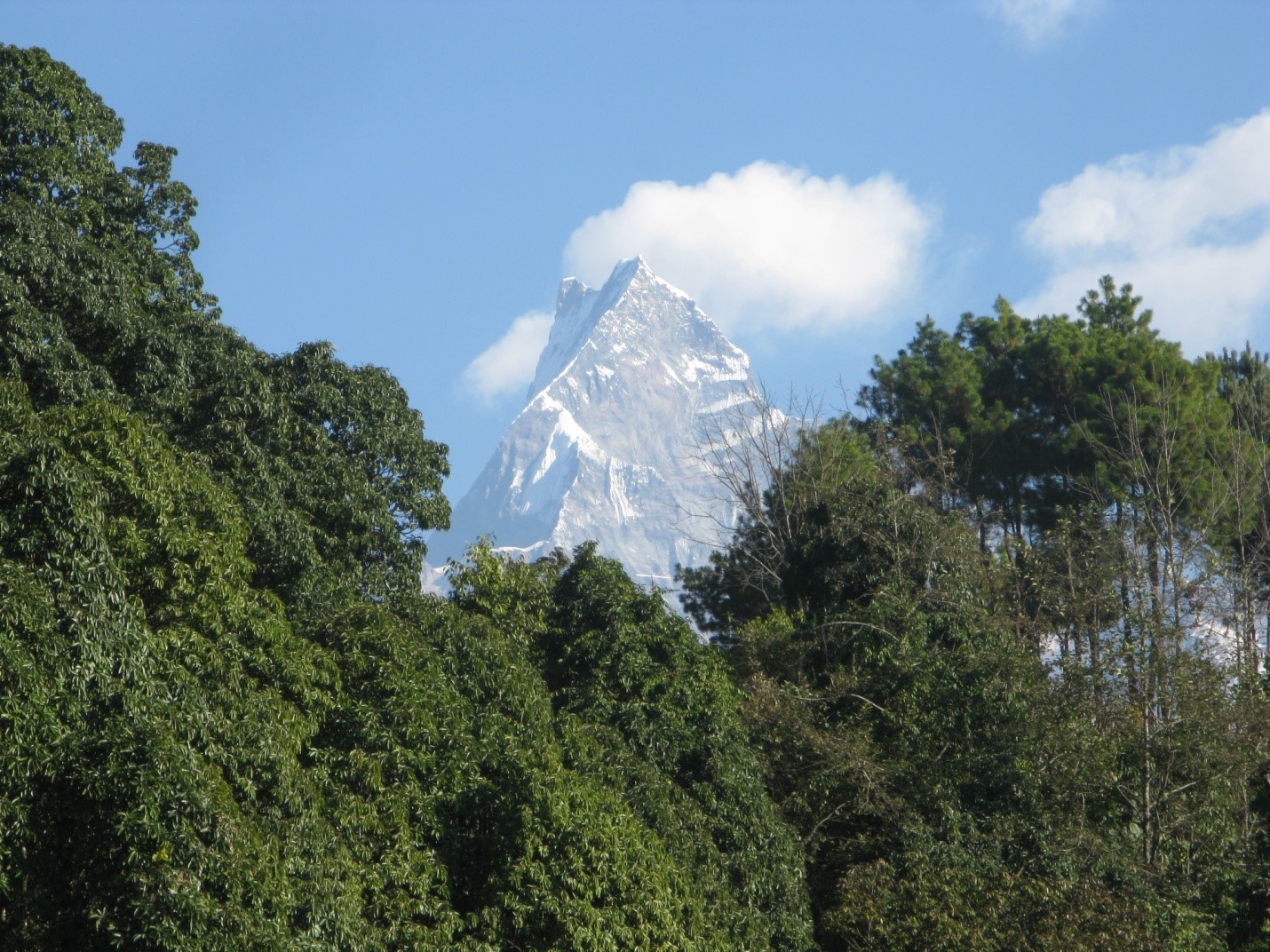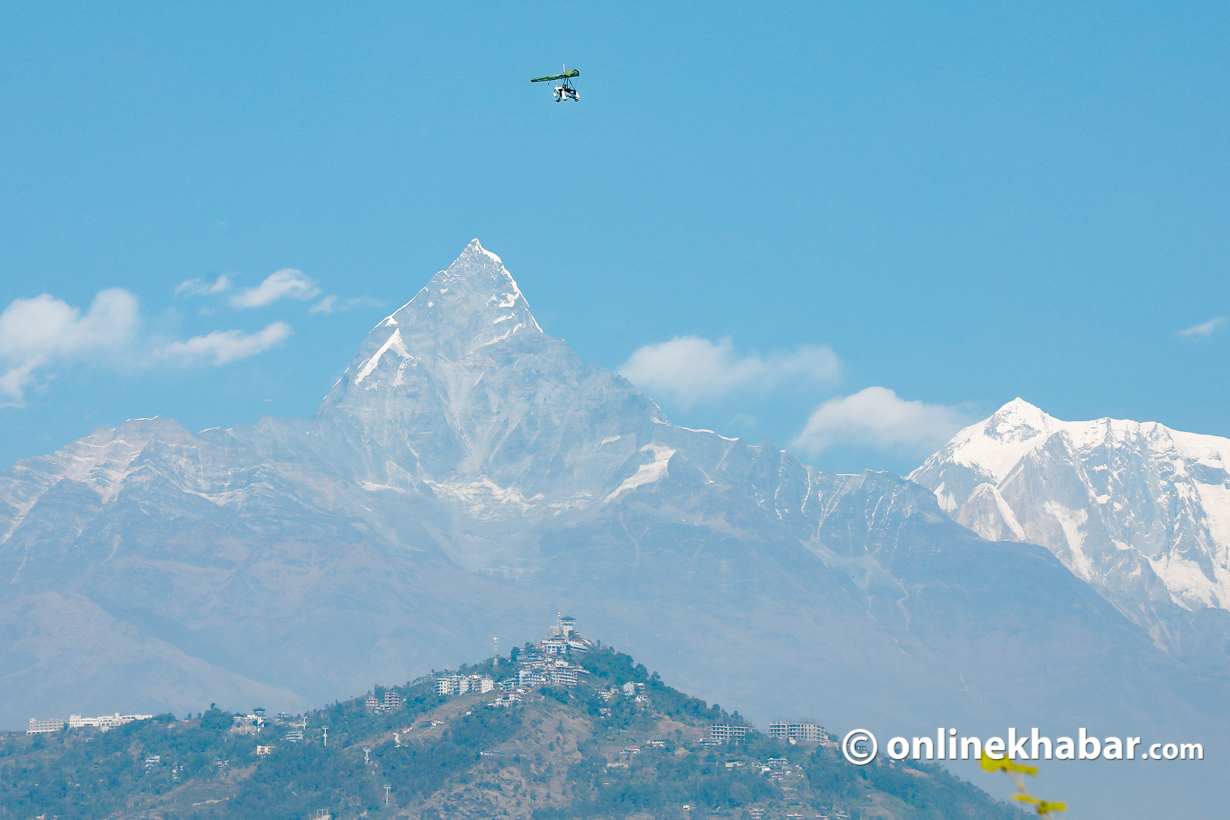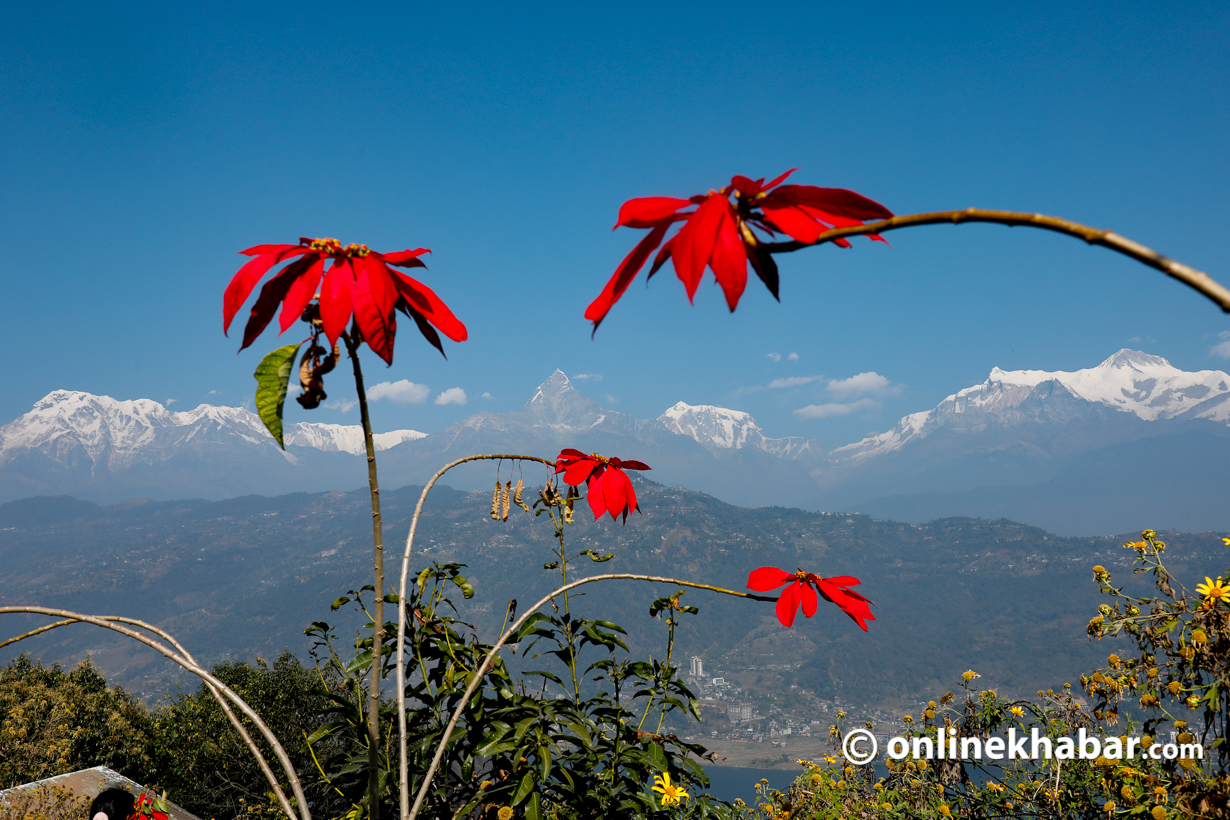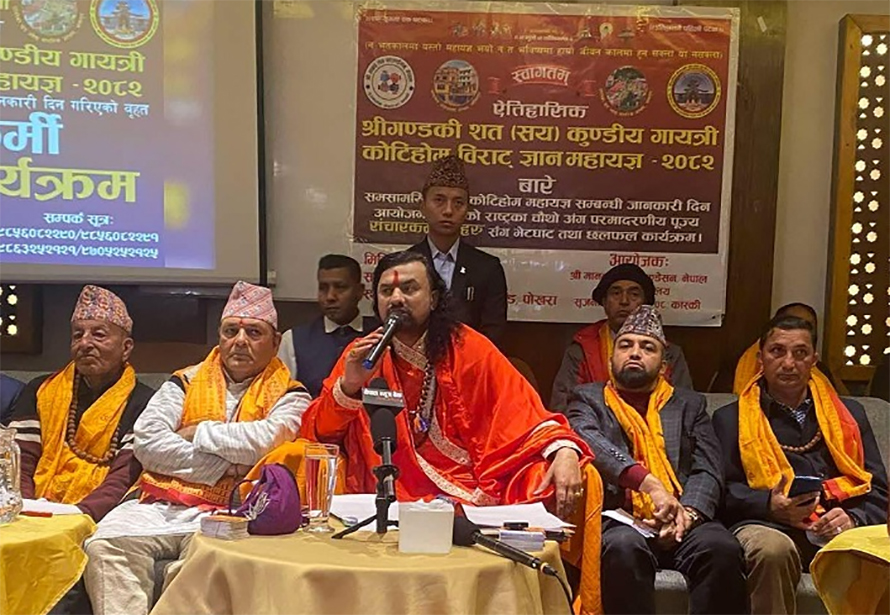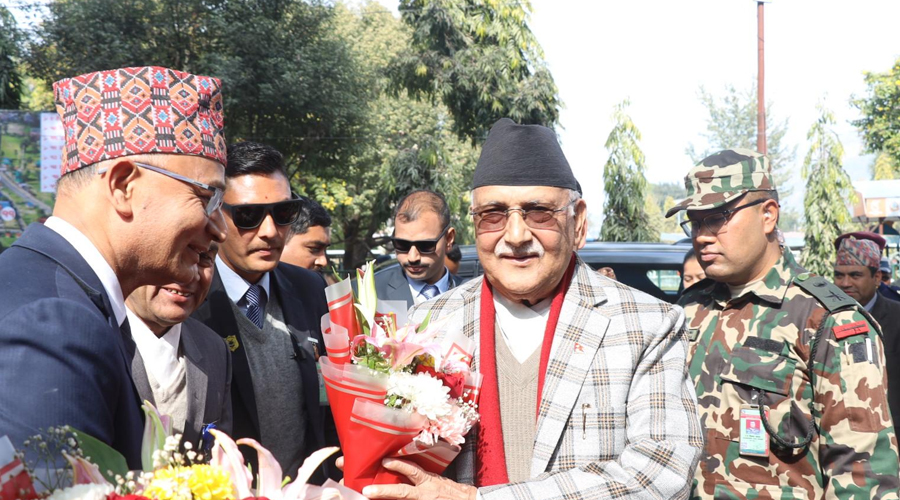It is Dhampus where you can get the best view of the Annapurna range without going to the Annapurna region—so writes the Lonely Planet.
Small wonder, the claim the local Dhampus folks make their small village-town offers one of the most commanding panoramas of the entire Annapurna massifs, is no idle gossip. So, if Dhampus is not on your bucket list when you plan a visit to Pokhara next—add it. It’s just a piddling 25 km away from the Lake City.
After a holidaying spree in Pokhara, if you fancy escaping a little away from the city to a quiet unsullied rustic countryside, this small Gurung village goes one better. This village is snugly tucked away on a brow of a hill punctuated by verdant forest and farmland that grows corn, millet, and buckwheat to velvety rice terraces (with the onset of monsoon) rippling down to the narrow Mardi river valley. If it is peak summer, the elevation of the Dhampus is a pleasantly cool 1,650 m as against the sultry and humid 827 m of Pokhara into the bargain. What’s more, you can travel to the place either by a vehicle, motorbike or take a two-hour leisurely hike from a place called Phedi, a 20-minute drive from Pokhara city on the Baglung Highway; or for that matter as a choice, pedal it on two wheels. Hikers will find the winding foot-trail uphill cut across terraced fields, wooded hills, and tiny villages like Jamuné, Dharné, and Pokharé.

The hike is rated moderate, recommended for people of all ages. When my family and I hiked, we ran into an eight-year-old Canadian kid taking it all in his stride along with his parents.
Peaks galore: The entire shebang

What strikes you as the absolute stunner when you arrive in Dhampus, before all else, is the northern skyline. The staggering snow-clad array includes the 7th and the 8th highest peaks in the world, the Dhaulagiri (8,167 m) and the Manaslu (8,156m), followed by the entire shebang: the Annapurna I (8,091 m), Annapurna II (7,937 m), Annapurna IV (7,525m), Hiunchuli (6,441m), Ganesh Himal (7,446m), Lamjung Himal(6,586m), and the Machhapuchhre (Fishtail Mountain: 6,993 m) in its iconic two-pronged glory.

Given a clear day, you can peer into the distance the Lake Phewa and the sprawling valley of Pokhara from the view-tower built on a hilltop above the Dhampus Bazaar.
Gateway to the Annapurna region
“Looking back, Dhampus, once (before the Pokhara- Baglung Highway opened) served as the only trekking route to the Annapurna trek hotspots such as Ghorepani, Ghandruk, Poonhill, the epics like the ABC (Annapurna Base Camp), the MBC (Machhapuchhre Base Camp), and the Annapurna Sanctuary. Even the remote outpost then, the gateway to Mustang, Jomsom had to be accessed through Dhampus,” said Ananta Prasad Bhandari when I met him eight years ago during a hike to Dhampus. He ran the Green View Restaurant in Pothana Deurali, some 25 minutes from the town square.

Although a dirt road was built sometime in 2009, the village remained unblemished by the trappings of development when last I visited Dhampus in 2018 on my mountain bike from Pokhara. The presence of old slate-roofed mud and stone houses on the lush hillsides, cultivated smallholdings, untouched woodland, and that calm laidback ambience, all spoke for themselves.
On two wheels
Cycling from Pokhara to the hill-town can thrill an avid biker every inch. The going can be tough as the dirt-road after Phedi steeply climbs for an unrelenting eight kilometres to the village-town. The return trip, however, offers an adrenaline-pumping ‘shredding’ downhill. Among many foreign visitors to Dhampus, some like to venture out on mountain bikes, too. Mountain bikes can be hired conveniently from several shops at Hallan Chowk, the Lakeside, Pokhara.
“The Dhampus trail remained brisk almost around the year with foreign backpackers, village people, and a sprinkling of domestic weekenders. But, things changed. With the Baglung Highway in operation, the number, however, dropped drastically as newer trekking routes to the Annapurna range opened,” Ananta added.
“With the growing number in domestic tourists in the recent years coupled with the opening of the trekking route to the Mardi Himal (5,587 m, to the south flank of the Machhapuchre) in the Annapurna region (7,600 sq. km), things have started to look up, however,” explained Ananta.
Hotels spoiled for choice
For a small village town, Dhampus hosts a plethora of hotels and lodges. Reservations can be made from Pokhara; failing, roadside hotel signboards help take your pick. Almost all hotels have access to the internet and running hot and cold water. The hotel tariff is moderately priced to suit your pocket from Rs 600.00 to 2,500 per night.
When it comes to food, it is a mélange of the East and the West—from basic dal-bhat, roti-veg-curry to burgers and sizzling steaks. Access by a vehicle to Dhampus is equally a cinch. Bolero jeeps and buses shuttle from Pokhara to Dhampus and back.
Reclining Buddha
If you are travelling by your vehicle, motorbike, or bicycle, slow down at Hemja (11 km from Pokhara) and keep watching the rolling lush hilltops to your left. Shortly, at a certain point, you will observe the wooded hills to your left curiously transform into the silhouette of a reclining Buddha facing the sky.
If you want more than a fleeting glance (you can catch a glimpse from a bus window, too, if you happen to be on the left side), stop and capture it on your camera or mobile phone. Most people do not know about the reclining Buddha or miss out on it.
Overnight stay

An overnight stay is recommendable if you plan to hike or take a ride. The best time to view the mountains is at sunrise unhindered by clouds or haze. Dhampus’s jewels in the crown are the mountains. There’s nothing like catching the sun as it sheds its first rays on the snow-clad peaks.
For that, you have to be an early riser. All you got to do is ask the hotel attendant for a wake-up call with tea if you prefer. If you are bent on having a clear view of the lofty peaks, the best time to visit Dhampus is October-November.
But, other times of the year except for mid-monsoon also suit fine, and the little village-town may offer you a view of the mountain range—if luck favours you. The summer, on the other hand, can be a pleasant retreat to escape from the hot and clammy weather of Pokhara to a bucolic setting.
Myth and mystery
Once comfortably checked into a hotel, take a stroll to the bazaar and stop by a nearby fabled pond called Neghu Baraha. A small temple, dedicated to Lord Vishnu (the Preserver of the Universe), stands by the historic pool. The locals aside, the shrine attracts devotees from far and near who come to worship and see the legendary pond for themselves.

Also, ancient watering hole visited by wild animals from the nearby dense forest, the pond is frequented by cattle and birds to drink from or to take a dip. That is not all. The pool carries an ancient myth, which is nothing short of a mystery.
“This venerated pond remains clean of leaves and fallen twigs all around the year. The trees shed leaves and dead twigs on the water, more so in winter. It’s but natural. But, come afternoon, the birds that flock by the tree pick the fallen leaves and twigs off the water. It’s been like this since the time of our great grandfathers—and theirs,” Dev Kaji Gurung, a hotel owner, shed light on the mystery. It sounded strange to me, if not incredible.
I was a little sceptical the first time (I have been to Dhampus five times). On each visit, I made it a point to look in on the pond. I would thoroughly scan the small pool for any sign of a leaf here or a twig there, but curiously I found the water spotless even though trees with outstretched branches stood at the fringe.
If you love jungle, try next, the eco-park built in the memory of great stalwarts of Nepal’s wildlife and conservation, late Dr Harkha Gurung, Dr Chandra Gurung, and Mingma Norbu Sherpa (all three died together in a helicopter crash). The Park Forest is home to abundant wild orchids and wildlife.
Fashion and bhangra

The fashion fever of the cities has taken a firm grip on the youngsters of Dhampus, too. Boys and girls walked the streets sporting jeans and skirts, some with headphones tucked into their ears. When I last visited the quintessential Gurung town, it was for me sight for sore eyes to observe elders still not broken away from tradition. I ran into a Tamu (Gurung) gentleman in a typical native white bhangra (a product from sisnu or nettle-brush fibres) held by a wide cummerbund, and a waist-coat. As he wore a ubiquitous Nepali Bhadgaunle (from Bhaktapur) topi (cap), a white cotton sack-bag slung across his chest in a crisscross—a rare sight these days.

Gurung women dressed more elaborately or generously with a phariya (sari) or a tubular pleated skirt, a blouse (blue-black or maroon-coloured) tied at the front, a cummerbund, a shawl, and a head-cover. During festivities, they are laden with jewellery that includes gold, coral, or glass-bead necklaces, earrings, nose-rings, bracelets, and bangles. For the un-used eye, the earrings look way too big to weigh heavily on the delicate earlobes. They are not. In truth, they are paper-thin, only the size belies their lightweight.
Flora and fauna
Next, a short hike to Pothana (1,974 m) can be a refreshing break, 25 minutes away up across a wooded hill. The trail, largely flight of stone steps, runs through the lush forest that includes oak, magnolia, rhododendron, chandan (sandalwood), needle-wood, and pine. The forest glades that intercept add to the charm. The woods offer sungabha or orchids galore, sprouting from moss and lichen-covered tree boughs and branches.

Bird watchers, trust my words! Gateway to ACAP (Annapurna Conservation Area Project) with the reputation of being a refuge for over 500 species of birds, the dense forest promises good sightings. The jungle is home to rare species like the hoary-throated barwing, the spectacled finch, and if Lady Luck smiles on you, the elusive endemic spiny babbler (Kande Bhyakur in Nepali; found only in Nepal), among many others. Better keep your binoculars handy!
More surprises may lie in wait for the unsuspecting hikers as coveys of pheasants may startle them by crossing their path and scurry away for cover. On the other, lone barking deer might saunter by. The thick forest is also home to the common leopards, only active nocturnally, though.
With the onset of March-April, the forest turns into a riot of colours as rhododendrons in full bloom blanket the forested hills. “Dhampus is home to six varieties of rhododendron: red, purple, white, pink, deep red, and maroon,” said Ananta.
After Pothana, a 20-minute walk up an unbroken forest chain brings you to the Australian Camp. Clusters of tiny settlements, lodges, homestays, and tea houses mark the place. What stands out most is a large green turf that faces the Annapurna range. Curiously, the local story has it, way back, the place previously known as Thulo Kharka (big pasture), came to be called the Australian Camp after a visiting Australian backpacker laid on the vacant plot grass-seeds brought from his country.

Further ventures
If you can extend a day or two, you can strike off to Ghandruk (another much-talked Gurung village). After Pothana, the trail winds its way along a forested ridge traversing Gurung villages like Pitam Deurali, Tolka, and Landrung. The high crest offers a staggering view of the Modi river valley to its west.
If your wanderlust drives you even farther, a three-four day trek from Ghandruk takes you to the ABC (Annapurna Base Camp) and MBC (Machhapuchare Base Camp). For that, you need a trained guide and logistic support available both in Dhampus and Ghandruk. The package can also include the Annapurna Sanctuary if you wish.
History
History has it, Dhampus, previously called Tome Le (meeting ground or even fisticuffs in Gurung dialect), once served as a Chaubise Rajya (one among 24 district principalities) said to be ruled by Khas kings.
After Prithvi Narayan Shah ascended to the throne in 1734, he annexed those petty states under his unification of Nepal. Ambar Gurung, owner, the Hotel Paradise View, helped me with the info. The ruins of an old fort remain at a wooded hillock called the Kot (Fort), 20 minutes from the town square. A shrine of Bhagawati stands next to the ancient ruins. The Dhampus people celebrate Dashain by offering goats and buffaloes for sacrifice to this deity.
If you are on a hike with a one-night stay, instead of back-tracking the same route, try the trail back via Dhikur Pokhari to Sarangkot or Kandé. It is worth the sweat, as the trail winds down forested hills and a beautiful stretch of country. From Kandé, you can catch a bus to Pokhara.

Indulge in local flavour
Every destination is known and recalled for its history, ambience, local folklore, and landscape. So it is by its local flavour, too: food. So, make a day of it by trying a dash of the local exotica: the millet dhindo (cooked dough), lamb sukuti (dried meat), locally grown sag (spinach), and if you do not mind trying the local aperitif, the jhwainkhatte (a blend of millet alcohol poured into a sizzling pan of rice grain fried in ghee). Do be warned, though—if one too many, you will either hit the bed straight or the hard floor!
In 2018, while on a mountain bike ride to Dhampus, I stopped on my way back by the Neghu Baraha. But lo behold, I failed to locate any trace of floating leaves or twigs on the surface—instead, two stout buffaloes wallowing in the water stared back at me with their doleful bovine expression. Fact or myth, perhaps you would like to find it out for yourself!
Images other than captioned by a source are by the author.



